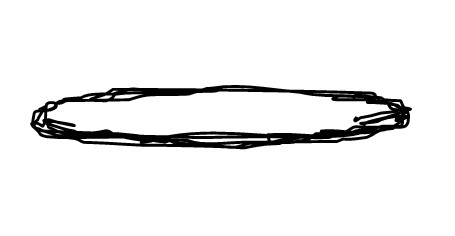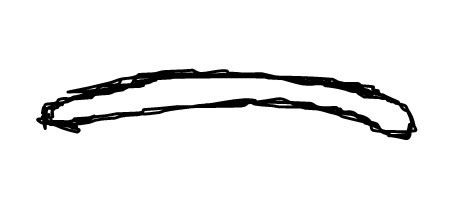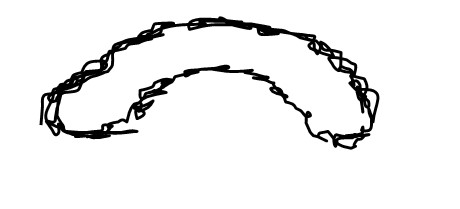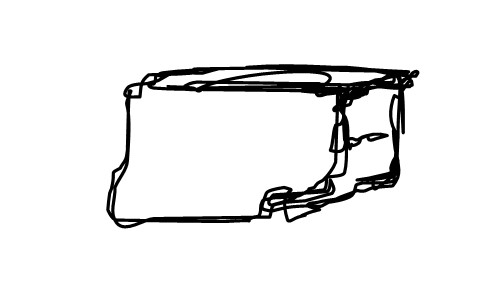The Importance of Soil in Crop Production
The ability of plant roots to grow, take up nutrients and water, and “breathe” is influenced by the physical and chemical properties of the soil. It is therefore essential that these properties are well understood.
In most cases, the soil available for crop cultivation is not ideal. This means the farmer has to correct or improve these soil conditions.
In almost all cultivation practices, plants require soil to grow in. Plants need soil for four main purposes, they are:
Stay Upright – Plant roots anchor the plant in the soil. This means that the roots must be able to penetrate the soil sufficiently to enable the plant to be anchored.
Nutrient Absorption – Plants take up, or absorb, nutrients from the soil through their roots. Plants can also absorb nutrients through their leaves, or foliage, but most often they use their roots.
Water Absorption – Plants absorb water through their roots from the soil.
Absorption of Oxygen (Air) – The roots of a plant, like the rest of the plant above the soil, has to absorb the air that the roots need for metabolic processes.
Soil Structure And Soil Texture
Soil properties can be divided into two groups, namely physical soil properties and chemical properties.
The physical properties of soil are to a great extent fixed and cannot easily be changed in the short term. These properties play a vital role in the sustainable productivity of soils. The physical properties can be evaluated visually.
The most important physical properties of soils are:
- Texture
- Structure
- Depth
- Layering or stratification
- Aeration
Soil texture is generally determined in a laboratory but can be estimated fairly accurately in the field. To do the field, estimate the following:
- Take about 50g of soil.
- Add water to wet the soil.
- Knead the soil into a thick paste.
- Roll the soil between the palms of your hands into a sausage; and
- Shape the soil “sausage” into a circle.
The soil textural class can then be determined as follows:
|
Textural Class |
Shape of Sausage |
Clay Content |
Illustration |
|
Sand |
It is not possible to roll sausage in the palm. The soil does not stick together. |
Less than 10% |
|
|
Loamy Sand (LoSa) |
It is possible to roll a sausage, but the sausage cannot be bent at all without cracking or breaking. |
10 to 15% |
|
|
Sandy Loam (SaLo) |
The sausage can be bent slightly, with the tips bent downwards for about 10mm without the sausage cracking in the middle. |
15 to 25% |
|
|
Sandy Clay Loam (SaClLo) |
The sausage can be bent down at the tips to about 20mm without cracking in the middle. |
25 to 35% |
|
|
Sandy Clay |
The sausage can be bent to form a semi-circle without cracking in the middle. |
35 to 50% |
|
|
Clay |
The sausage can be bent to form a complete circle without cracking in the middle. |
>50% |
|
Textural Triangle
A soil texture triangle is used to classify the texture class of soil. The sides of the soil texture triangle are scaled for the percentages of sand, silt, and clay. Clay percentages are read from left to right across the triangle (dashed lines). Silt is read from the upper right to the lower left (light, dotted lines). Sand from the lower right towards the upper left portion of the triangle (bold, solid lines). The boundaries of the soil texture classes are highlighted in blue. The intersection of the three sizes on the triangle gives the texture class. For instance, if you have soil with 20% clay, 60% silt, and 20% sand it falls in the "silt loam" class.
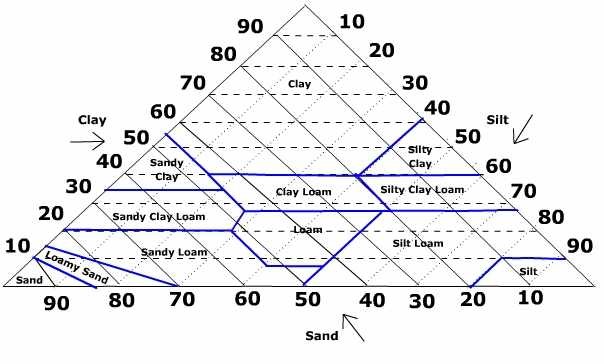
Soil Structure
Soil structure refers to the manner in which all the soil particles, including organic material, are arranged to form structural units. The structural units are named according to their physical appearance, as follows:
|
Structural Unit |
Description |
Illustration |
|
No structure |
This is usually the case in sandy soils where no aggregation of soil particles is present. The soil falls apart when removed from the profile. |
|
|
Plate-like |
The natural cracks are horizontal. |
|
|
Prismatic |
The vertical cracks are better displayed than the horizontal ones. The units are 2 to 5 times as long as they are broad. |
|
|
Blocky |
The vertical and horizontal cracks are evenly developed, and the dimensions of the units are about the same. The units have sharp edges and smooth faces. The unit range in size from 1mm to 50mm. |
|
|
Granular |
These units have rounded edges with rough faces. They range in size from 1mm to 10mm. When wet, these units trap more air than the blocky or prismatic units. |
 |
Soil structure is a very important property that regulates processes related to plant production. These include aeration, water penetration and drainage. If the structure of the soil is destroyed, the soil becomes anaerobic (containing no oxygen) and waterlogged.
Soil can also be classified using other systems where the relationship between the percentage of clay, silt and sand are presented in a triangle. This is a more sophisticated classification. This triangle shows twelve different textural classes. The sand section is for instance split into three different classifications, being coarse, medium and fine sand. The average size of the clay particles is <0.002mm, that of silt 0.05mm to 0.002mm and sand 0.05mm to 2mm.
An aspect of soil texture is the content of particles larger than 2mm. This fraction is referred to as gravel and/or stones. When the gravel content of the soil exceeds 10%, it should be taken into account when interpreting the chemical composition of the soil. Gravel dilutes the concentration of available nutrient elements.
Clay and organic matter (humus) are the active materials in the soil. The humus content of soil can be intentionally increased, but it is more often decreased by agricultural practices. The clay content, however, is a fixed property and cannot be changed economically. The type and concentration of clay determine the cation-exchange capacity, water-holding capacity, aeration, and many other soil properties. The type of soil preferred by different crops differs between crops. The ideal soil for example for citrus production is one that contains less than 50% small particles (fine sand, silt and clay) and less than 25% clay. The figure below shows the relationship between clay content and soil suitability for citrus production.
Clay content:

Suitability for Citrus Production - Clay Content of Soil vs. Suitability for Citrus Production
Soil Depth
The depth at which impermeable layers and/or parent material are present determines soil depth. Soils with a depth of less than 500mm are generally regarded as a soil of low potential. The effective depth of soil is the depth to which the crop roots can penetrate with ease.
Soil Layering or Stratification
It takes about 1,000 years for a 25mm layer of soil to develop. During the formation of soil, soil particles are separated and accumulate at various depths. Soils are also carried and deposited by water and wind to form soil layers with different soil properties.
The soil layers have an influence on the potential of the soil. If the properties, especially the texture, of the two underlying soil layers differ too much, plant roots will not grow into the next layer. Similarly, water will not penetrate the second layer, but rather flow away along with the merger of the two layers. A simple way to determine if layering could be a problem is by determining the texture of both layers. If the texture differs by more than 50% the layer will cause a problem. If for example, the topsoil contains 20% clay and the next layer more than 30% (50% of 20=10%), the stratification of the soil is too severe and will impede root growth and water movement.
Soil Aeration
Plant roots respire (use oxygen and excrete carbon dioxide) and so soil oxygen must be replaced constantly. The rate at which oxygen-carrying air moves through soil depends on factors such as soil pore size. The size of the soil pores depends on the texture, structure and strength of the soil.

The soil pores are filled with water and air, with the ratio between air and water being determined by the water content of the soil. At field water capacity (FWC), the soil air content is at its minimum. As the plant roots absorb the water in the soil, the air content in the soil increases. In soils that are poorly drained, the pores are filled with more water than at FWC and less air (oxygen) will be present. Waterlogged soil, therefore, contains very little oxygen and the anaerobic conditions that develop cause roots to die.
Field Water Capacity (FWC): is reached when there is no free water is present in the soil. All the water present is bound to the soil particles. This means that water does not move out of the soil profile through leaching.
Chemical Soil Properties
The chemical properties of soil are constantly changing and can be changed. The most relevant chemical properties of soil are:
- pH
- Resistance or electrical conductivity
- Fertility
- Salinity
- Cation exchange capacity
- Organic matter
Soil pH
pH is a measure of the concentration of the hydrogen ion (acid ion). A pH reading can range from 1 (extremely acidic) to 14 (extremely alkaline). A pH value of 7 is neutral.
When the pH of the soil is measured, a suspension of the soil is prepared. pH values are reported as pH (water) and pH (KCl). Remember that the pH (water) is on average one unit higher than pH (KCl) for the same soil.
The optimal pH (water) of soil for most crops ranges from 6.50 to 7.50. When the pH (water) drops below 5.30, too much aluminium is present in the soil. Aluminium is toxic to roots and root growth will be affected. If the pH (water) exceeds 7.50, nutrient elements like phosphate, zinc and manganese become insoluble and deficiencies can be induced.
In soils with a neutral to acid pH, the pH of the subsoil will usually be lower than that of the topsoil.
Electrical Conductivity and Resistance
Electrical Conductivity: Electrical conductivity refers to the ability of soil paste to conduct electrical current and can be expressed in various units of conductivity. The international standard (IS) unit is Siemen.
Resistance: Resistance is the opposite of electrical conductivity and refers to the resistance of soil paste to the conductance of electrical current. Resistance is expressed in Ohms.
The resistance of soil is an indication of the total dissolved salts in the soil solution. The measurement of resistance is a quick method to scan soils for salts. If the sample is too salty the electrical conductivity (EC) of the saturated paste is measured. The resistance is expressed in ohm and the following general classification can be used:
Clay Content |
Optimal Resistance |
|
> 35% |
250 to 500 ohms |
|
20 to 35% |
500 to 750 ohms |
|
10 to 15% |
750 to 1,000 ohms |
|
< 10% |
>1000 ohms |
Soil Fertility
Soil fertility is a collective expression to describe the status of the soil in terms of phosphorus (P), potassium (K), calcium (Ca), magnesium (Mg) and to some extent, nitrogen (N). Fertile soil contains these nutrient elements in adequate quantities to sustain plant growth.
If too few plant nutrients are present, it poses less of a problem in commercial agriculture than if too much is present. It is relatively quite easy and fairly cheap to add nutrient elements to the soil, but seldom easy and cheap, if possible, at all, to remove excess nutrients.
Soil Salinity
Salts accumulate in soils due to poor drainage and irrigation using saline water. This is usually a slow process and affects the fertility of the soil and eventually also the physical properties and soil structure.
Cation Exchange Capacity (CEC)
Clay particles carry electrical charges of which the majority are negative. These negative charges can attract and bind with cations in the soil solution. The cations, which are positively charged forms bonds with the clay and can be displaced by other cations. The magnitude of negative charges present to absorb cations is referred to as the cation exchange capacity (CEC) of the soil and is expressed in centi-molar charge per kg of soil (cmol+/kg). Organic matter also has a CEC, as well as an anion exchange capacity similar to the CEC, but that absorb negatively charged anions.
The CEC of soil depends on the clay content, the type of clay, and the organic matter content. Under certain circumstances CEC may be pH-dependent, i.e. it will change when the pH changes.
Soil Organic Matter
Organic matter present in soil ranges from dead plant and animal material, organic debris, microbial debris and all stages of humus. Humus is processed and condensed organic matter and it takes thousands of years to reach a stable form. Humus contributes to the activity in soils and consists of humic acid (or humates, the salts of humic acids), fulvic acid (or fulvates, the salts of fulvic acid) and humins (a very stable form).

The Role of Soil Minerals
Soil is composed of minerals, most of which are essential nutrient elements for plant growth. Each essential nutrient element has a particular role or role in the physiology of plants. These nutrients are called essential elements because without them plants cannot complete their lifecycle from seed through the vegetative and reproductive stages to the seed formation stage. The essential elements are grouped into macro and micro nutrient elements.
Macro elements are required in relatively large amounts, while micronutrients are required in very small amounts. The role of each element is complex, and elements are involved in many physiological processes of which some are still not understood.
|
Essential Nutrient Element |
Function |
|
|
Nitrogen (N) |
Forms part of all protein and enzyme molecules and is therefore involved in almost every physiological process in plant production. |
|
|
Phosphorus (P) |
Is involved in all energy transfer reactions in the plant. It is also part of the nucleic acids in cells. |
|
|
Potassium (K) |
Has many roles, including cell division and transport of photosynthetic products from the leaves to the roots and other parts. |
|
|
Calcium (Ca) |
Forms a vital part of all cell walls, keeping the cells together in the same way as cement in a brick wall. |
|
|
Magnesium (Mg) |
Forms the centre metal ion in the chlorophyll molecule, which is required for photosynthesis, apart from its role in other physiological processes. |
|
|
Sulphur (S) |
Is involved in the production of sulphur-containing amino acids and in reproductive processes. A sulphur deficiency will reduce flowering and fruit set. |
|
|
Sodium (Na) |
Can replace potassium to some extent in certain plants. |
|
|
Chloride (Cl) |
Is in fact also a micro-nutrient, with plants requiring about 20mg per litre in their nutrient solution. Chloride is involved in the reactions where water molecules are split during photosynthesis. |
|
|
Micronutrient elements Cu, Fe, Mn, Zn, B and Mo |
Are involved in many physiological reactions as catalysts. |
|
The Role and Function of Essential Nutrient Elements (Summarised)
